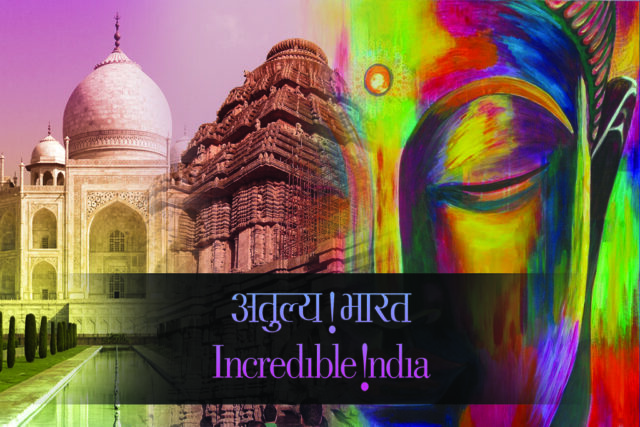India’s age old tradition of ‘Atithi Devo Bhava’, ‘Our Guest Is God’ has welcomed millions of tourists from around the world. India’s geographical and cultural diversity, it’s 38 World Heritage Sites, it’s spiritual circuits and exotic locals make India a complete tourist experience. The World Travel and Tourism Council calculated that tourism generated US$ 194 billion contributing to 6.8 percent of India’s GDP in 2019.
As of 2019, 87 million people were employed in the Indian tourism sector, contributing 8.1 percent of the total employment in the country. India also has a place for niche tourism which is a rising trend. These include Meetings, Incentives, Conventions and Events (MICE), cruises, adventure, religious, spiritual, medical, rural and economic tourism. Tourism in India provides a wonderful window to our varied life, culture, historical places, wildlife sanctuaries and flora and fauna. Tourism has become the world’s largest and fastest growing industry. India is the second largest foriegn exchange runner as one of the biggest service sector contributors.
The Ministry of Tourism, Government of India, through its 08 offices overseas endeavours to position India in the tourism generating markets as a preferred tourism destination, to promote various Indian tourism products vis-à-vis competition faced from various destinations and to increase India’s share of the global tourism market.
The following places should not be missed if you plan on visiting India-
- Swaminarayan Akshardham at New Delhi is a mandir- an abode of God, Hindu house of worship, a spiritual and cultural campus dedicated to devotion and harmony. Each element of Akshardham echoes with spirituality.
- Taj Mahal- A monument made of white marble, the Taj made it to the list of the seven wonders of the world. Built in the 17th century, by Mughal emperor Shah Jahan, in memory of his favourite wife. A jewel of muslim art in India and a masterpiece, this monument is situated in Agra, 231kms away from New Delhi.
- Hawa Mahal- It is a palace in Jaipur, India approximately 300 kilometers from the capital city of Delhi, also known as the ‘ Palace of Breeze’. Built from red and pink sandstone, the palace sits on the edge of the City Palace, Jaipur, and extends to the Zenana, or women’s chambers.
- Elephanta Caves- The ‘City of Caves’, on an island in the Sea of Oman close to Bombay, contains a collection of rock art linked to the cult of Shiva. Here, Indian art has found one of its most perfect expressions, particularly the huge high reliefs in the main cave.
- Dashashwamedh Ghat Arti- The Ganga Aarti Ceremony held every evening at the Dasashwamedh Ghat at Varanasi is one of the most spectacular religious or devotional rituals carried out in the world. The religious ceremony is held close to one of the most famous temples for pilgrims in India, Kashi Vishwanath Temple.
- Golden Temple- Also known as Harmandir Sahib, meaning “abode of God”, it is a Gurdwara located in the city of Amritsar, Punjab, India. It is the preeminent spiritual site of Sikhism.
- Red Fort- This 17th century fort was built by the Mughal Emperor Shah Jahan and served as the capital of the Mughals until 1857. Every year on India’s Independence Day (15 August), the prime minister hoists the Indian “tricolour flag” at the fort’s main gate and delivers a nationally broadcast speech.
- Gangtok- It is famous for handicrafts and Tibetan carpets which reflect the arts and culture of the city. Hand-woven jackets are extremely exquisite and pretty and a must-have souvenir. Sikkim is popular worldwide for its most delicious tea.
- Khajuraho Temple- The Khajuraho Group of Monuments is a group of Hindu temples and Jain temples in Madhya Pradesh. They are a UNESCO World Heritage Site. The temples are famous for their nagara-style architectural symbolism and their erotic sculptures.
- Kaziranga National Park- One of the most sought after wildlife holiday destinations in India, Kaziranga National park was declared as a World Heritage Site by UNESCO in 1985. The park has successfully managed to grow the population of Greater one-horned rhinoceros, an endangered species.
- Humayun’s Tomb- This tomb, built in 1570, is of particular cultural significance as it was the first garden-tomb on the Indian subcontinent. Humayun’s garden-tomb is also called the ‘dormitory of the Mughals’ as in the cells are buried over 150 Mughal family members.
- Konark Temple- A UNESCO World Heritage Site, Konark Sun temple is a striking model of ancient artistry, fluidity of ideas, and a pedagogic treasury. Dedicated to the sun god, Surya, the first rays of the sun fall on the entrance of the temple.
- Darjeeling- Darjeeling is a town in India’s West Bengal state, in the Himalayan foothills.It is noted for its tea industry, its views of Kangchenjunga, the world’s third-highest mountain, and the Darjeeling Himalayan Railway, a UNESCO World Heritage Site.
- Mahabodhi Temple- The Mahabodhi Temple Complex is one of the four holy sites related to the life of the Lord Buddha, and particularly to the attainment of Enlightenment. The first temple was built by Emperor Asoka in the 3rd century B.C.
- Sanchi Stupa- The Great Stupa at Sanchi is one of the oldest stone structures in India, and an important monument of Indian Architecture. It was originally commissioned by the emperor Ashoka in the 3rd century BCE. Its nucleus was a simple hemispherical brick structure built over the relics of the Buddha.
- Rann of Kutch- The Rann of Kutch is famous for its white salty desert sand and is reputed to be the largest salt desert in the world.It is also a place known for its artistic handicrafts.









